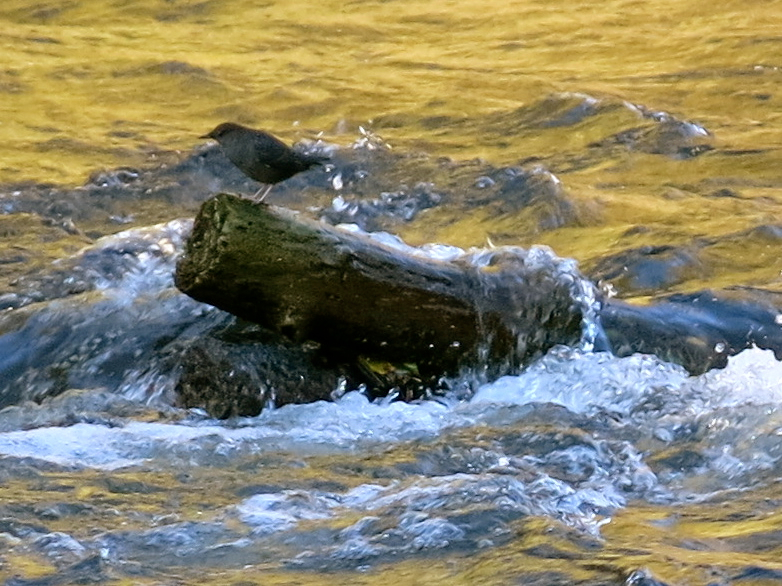
American Dipper in the Applegate River, Applegate, Oregon, near the Applegate Store and Cafe.
(As my cousin Sue pointed out, this bird is also called an ouzel, which sounds much more mysterious.)
Yet Another Unitarian Universalist
A postmodern heretic's spiritual journey.

American Dipper in the Applegate River, Applegate, Oregon, near the Applegate Store and Cafe.
(As my cousin Sue pointed out, this bird is also called an ouzel, which sounds much more mysterious.)
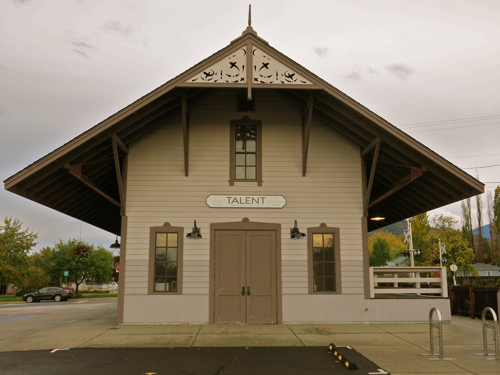
The old railroad depot at Talent, Oregon. The sign reads: “To Portland 336 mi. / TALENT / To San Francisco 436 mi. / Elevation 1,635”
My cousin Sue tells me that up until a few years ago, two trains a day passed through Talent, carrying lumber south to Redding, California. With the collapse of the timber industry in this part of Oregon, there are no more regularly scheduled trains — this, along with the mills closing down, and good working class jobs disappearing, represents the changing economy of southwestern Oregon. The railroad depot has been converted into shops, perhaps a symbol of the growing importance of service industry jobs.
Nights get cool in the dry desert air of Elko, and we left the window of the motel room open all night. We got on the road while the air was still cool. We were about to turn on the audiobook we have been listening to — Chaucer’s Canterbury Tales, in the translation by Burton Raffles — when I saw a sign by the side of the road: “California Trail Interpretive Center.”
“Do you mind if we stop there?” I said to Carol. She knew that I have become mildly obsessed with the California Trail on this trip, so she agreed we could stop.
We climbed up the short trail behind the Interpretive Center building, and looked down on the Humboldt River valley: the narrow river winding along the low point of the broad valley; bright green grass and even a few trees growing near the river; the green grass giving way to sagebrush as the land sloped up away from the river; and then, rising more and more steeply above the level of the sagebrush, the stark and almost bare slopes of towering mountains.
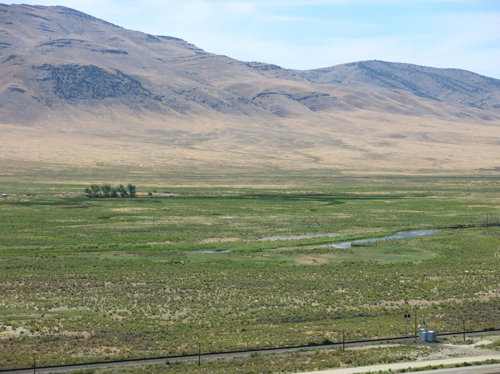
Above: The Humboldt River valley east of Elko, Nev.
Edwin Bryant, in his 1848 book What I Saw in California, described how his party made the difficult crossing of the salt flats west of Great Salt Lake, and then made their way across the often steep and difficult terrain of what is now western Nevada, finding barely enough water, and barely enough grass for their mules, at widely spaced springs. After more than a week of travel through this harsh desert, Bryant and his party found a small tributary stream which finally led them to the Humboldt River (which they called Mary’s River):
“We emerged into the spacious valley of Mary’s River, the sight of which gladdened our eyes about three o’clock, P.M. At this point the valley is some twenty or thirty miles in breadth, and the lines of willows indicating the existence of streams of running water are so numerous and diverse, that we found it difficult to determine which was the main river and its exact course…. At sunset we encamped in the valley of the stream down which we had descended, in a bottom covered with the most luxuriant and nutritious grass. Our mules fared most sumptuously both for food and water.”
Today, the Humboldt River valley looks somewhat different than it did in Bryant’s day: the river has been restricted to one main channel; most of the trees are gone and the river bottoms are used by farmers to grow feed for cattle; cattle graze on sagebrush above the river bottom; and the interstate highway and a railroad run between the agricultural land and the grazing land. But even in this time of interstate highways and air conditioned automobiles, I still found the green of the valley to be a welcome sight in the midst of a land that appeared to me to be dry and forbidding landscape.
My perception of this land as dry and forbidding is not shared by the Te-Moak Tribe of Western Shoshones. On their tribal Web site, they write: “This vast land of mountains, valleys, deserts, rivers, and lakes offered an abundance of wildlife and plants for the Shoshone to hunt, fish, and gather. The Newe [the name by which they call themselves] knew their lands and cared for its natural balance; for them it was a land of plenty.” And, Steven J. Crum, in his book The Road on Which We Came: A History of the Western Shoshone (Salt Lake City University of Utah Press, 1994), quotes a Western Shoshone song:
“How beautiful is our land,
how beautiful is our land,
forever, beside the water, the water,
how beautiful is our land.
“How beautiful is our land,
how beautiful is our land,
Earth, with flowers on it, next to the water,
how beautiful is our land.”
We kept driving west, generally following the course of the Humboldt River, for the next two or three horus. Bryant and his party followed the Humboldt River for more than a week, from August 9 through August 19, when at last they reached the Humboldt Sink — that place where the river terminates:
“We came to some pools of standing water, as described by the Indians last night, covered with a yellowish slime, and emitting a most disagreeable odor. The margins of these pools are whitened with an alkaline deposit, and green tufts of a coarse grass, and some reeds or flags, raise themselves above the snow-like soil.”
The Humboldt Sink is another weird landscape, forty-five miles of undrinkable water, halophytes or salt-loving plants, whitish soil — and forty-five miles of misery for the early travelers along the California Trail. The Western Shoshone appear to have been smart enough to stay out of the Humboldt Sink. But the white emigrants had to cross it in order to get to California. Mark Twain had to cross it in his 1861 trip by stagecoach in order to get to his final destination of Carson City:
“…forty memorable miles of bottomless sand, into which the coach wheels sunk from six inches to a foot…. It was a dreary pull and a long and thirsty one, for we had no water. From one extremity of this desert to the other, the road was white with the bones of oxen and horses. It would hardly be an exaggeration to say that we could have walked the forty miles and set our feet on a bone at every step! The desert was one prodigious graveyard. And the log-chains, wagon tyres, and rotting wrecks of vehicles were almost as thick as the bones. I think we saw log-chains enough rusting there in the desert, to reach across any State in the Union. Do not these relics suggest something of an idea of the fearful suffering and privation the early emigrants to California endured?”
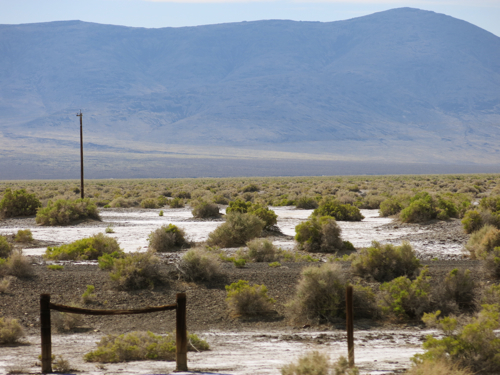
Above: The Humboldt Sink near Interstate 80 in Nevada
Why did those early emigrants make that trip? — traveling west for hundreds of miles into uncertainty. The emigrants may have been able to give rational explanations of their desire to emigrate; but, suggests historian George R. Stewart, there were other, non-rational, factors at work:
“We may suspect some unconscious motivation. Moving was an established folk custom. Most of these people had already moved once, or oftener, and to do so again was only natural. Moreover we may suspect that many of them were driven on by mere boredom. To exist for a few years on a backwoods farm with almost no means of amusement or stimulation meant the build-up of an overwhelming desire to see new places and people.” (The California Trail [New York: McGraw Hill, 1962].)
It seems a little extreme to suggest someone would travel that far into such uncertainty out of boredom; Mark Twain was driven to emigrate to Nevada out of a species of boredom, but that was later, when there was regular stagecoach service across the continent. But boredom is related to other human feelings, including religious feelings — what is meditation, but organized boredom? — and as meditation is related to boredom, so are both related to ecstasy. The early travelers along the California Trail must have endured mind-numbing boredom at some stages along the trail; but in other places they experienced the terrifying sublimity, the awe-inspiring grandeur, of the land; the awe and sublimity and terror amplified by partial starvation and fear and exhaustion, and their earlier boredom. We drove most of the day through the Nevada landscape on not enough sleep, we were sometimes bored by driving, and we were awe-struck by the sight of the mountains and canyons; terrified by the steep winding downgrades; horrified by the sight of a fire-blackened hulk of a truck that we passed in slow single-file line of vehicles as fire fighters put out the last of the brush fire that the explosive burning of the truck had started, passed in horrified realization that no one could possibly be left alive after that crash and fire, that crash that obviously came from the truck losing control on one of those steep winding downgrades that we were now negotiating. The emigrants had far more intense experiences that lasted far longer, and extended over months. Such things work changes on one’s being.
On the other side of the Humboldt Sink, the interstate roughly follows the Truckee River — again, one of the routes of the California Trail, a route that guaranteed fresh water and forage for oxen and mules. We stopped at the rest area at Donner Pass — this rest area is not far from where the ill-fated Donner party were snowbound, and where nearly half the party died — and to stretch our legs we walked a short distance along the Pacific Crest Trail.
There we met a man who was through-hiking the Pacific Crest Trail. He was older than the typical through-hiker, ten or twelve years older than I, and since we were near contemporaries of his, it was easy to wind up talking with him. He told us about walking 700 miles through the desert, sometimes having to carry enough water to last him for 30 miles. When he got to the high Sierras, the altitude hit him hard, slowing him down until he became finally acclimated. Carol asked about the logistics of renewing his supplies, and he said that once he had to walk a full day, or about fifteen miles, off the trail to pick up supplies, and then walk a full day to get back on the trail.
His motivation for taking on such a physically and mentally challenging trip was simple: his son was killed in an accident, then his wife died, and he had to do something. We talked about what might motivate other through-hikers. “We’re listening to The Canterbury Tales as we drive,” I said, “and I think through-hiking is a kind of modern-day pilgrimage.” Through-hikers have no pilgrimage destination, no Canterbury with Saint Thomas’s remains at journey’s end; there is only the journey. But like the pilgrims going to Canterbury, and like the emigrants, they begin their journeys with the advent of warm weather:
“When Zephyrus eke with his swoote breath
Inspired hath in every holt and heath
The tender croppes and the younge sun
Hath in the Ram his halfe course y-run,
And smalle fowles make melody,
That sleepen all the night with open eye,
(So pricketh them nature in their corages);
Then longe folk to go on pilgrimages….”
So, too, I began to long for this cross-country trip in the early spring, looking through the road atlas to choose a route, making plans about where we would stop, dreaming about when we could start driving.
All pilgrims must complete their journeys before the harsh weather of winter sets in. Our through-hiker worried that he might be walking too slowly, he might not make it through the mountains of Washington before the winter snows set in. I said I wasn’t sure that mattered, and he allowed that the journey was what he most wanted, and needed.
As for us, our journey is almost complete. Our journey has been relatively comfortable: riding in a car, stopping when we feel like it to take a walk or look at scenery, sleeping in motels. Our journey has been relatively quick: a matter of days, not weeks or months. But as we drove down out of the Sierra Nevadas, down into the wide Central Valley, through the traffic of Sacramento, I feel a change in myself — not enough of a change, but a change. That’s what the early emigrants on the California Trail were looking for: a change; a change in circumstances, but also I think an inner change. Mark Twain was looking for a change in circumstances when he went by overland stage to Carson City, Nevada, and after seven years in the West found that what had changed most was — not external circumstances — but himself.
We kept on driving west, driving towards the sun setting over the Coastal Range, the western-most range of mountains in this part of North America.
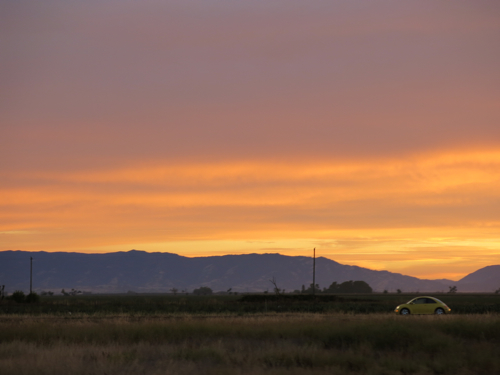
Above: The Coastal Range near Winters, Calif.
Somewhere beyond those purple mountains lies San Francisco Bay, on the edge of which we live; and beyond one last ridge of the Coastal Range lies the Pacific Ocean, extending into vastness beyond the limits of sight. And as we see the sun set behind the mountains, we know that we will not reach our final destination before night settles in on us.
We made a detour to Red Canyon, part of Flaming Gorge National Recreation Area. For an hour and a half, we walked through Ponderosa pine woods, stopping now and again at one of the overlooks set up to offer perfect picture postcard views of the sheer red sandstone walls of the canyon dropping a thousand feet down to the perfect emerald water of the reservoir. It is almost impossible to take a bad photograph of Red Canyon.
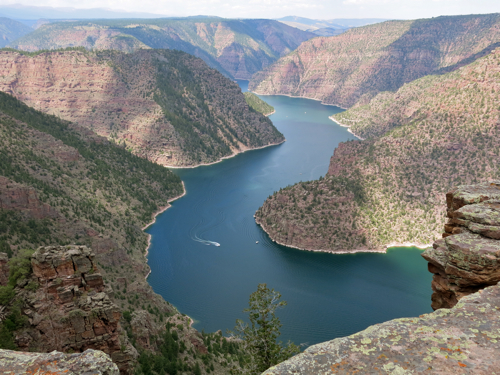
Above: Red Canyon, Flaming Gorge National Recreation Area in Utah
We drove back to the interstate, across broad sagebrush-covered plains, down steep, twisting roads, emerging every once in a while into valleys that were bright green with irrigated agricultural fields.
Sagebrush and mountains dominated the landscape. The interstate plunged down into Echo Canyon, historic route of the Hastings Cutoff on the California Trail. Somewhere in Echo Canyon there are the remains of stone breastworks erected by early Mormons as an act of defiance, as they prepared for an invasion by the U.S. Army; the army had spent months moving its troops westward and was camped out for the winter near Fort Bridger, Wyoming, prepared to forcibly extend the territorial rule of the United States over the Mormon theocracy. Open war was averted, barely. Eventually the coming of the railroad changed the political landscape, by making it far more difficult for the Mormon hierarchy to remain so isolated — and by making it obvious to all concerned that the U.S. Army could mobilize forces, not in a matter of months, but in a matter of days.
We stopped at a rest area in Echo Canyon, and climbed a fifty-foot high hill that was covered in sagebrush bushes ranging in height from two feet to the extraordinary height of seven feet. I looked at one of the seven-foot-high sagebrush bushes. Mark Twain was right; squinting my eyes and using my imagination, the sagebrush turned from a small bush into a huge old tree towering over me:
“If the reader can imagine a gnarled and venerable live oak-tree reduced to a little shrub two feet-high, with its rough bark, its foliage, its twisted boughs, all complete, he can picture the ‘sage-brush’ exactly. Often, on lazy afternoons in the mountains, I have lain on the ground with my face under a sage-bush, and entertained myself with fancying that the gnats among its foliage were liliputian birds, and that the ants marching and countermarching about its base were liliputian flocks and herds, and myself some vast loafer from Brobdignag waiting to catch a little citizen and eat him.”
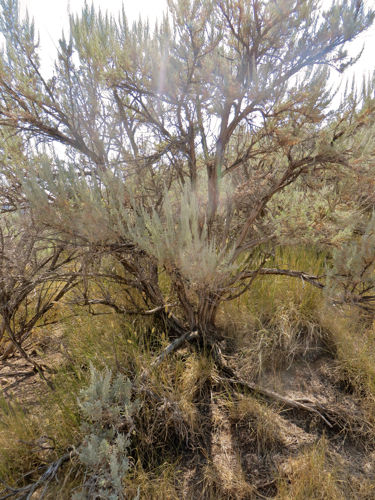
Above: Seven-foot high sagebrush in Echo Canyon, Utah
As we drove along, I compared our route on a map of the California Trail published by the National Park Service; I also looked at the official highway map of the state of Utah, which shows the historic route of the Hastings Cutoff of the California Trail, in greater detail and with more accuracy than the Park Service map. After Echo Canyon, the Hastings Cutoff went north of present-day Interstate 80. Leaving Salt Lake City, the interstate crosses a part of Great Salt Lake that is often dry, while the Hastings Cutoff followed higher ground along the base of Oquirrh Mountain, then in along the Tooele Valley, and up over Hastings Pass. The old trail passed by some fresh water springs, crossed over the present route of Interstate 80, then across great slat flats.
It’s hard to imagine what it must have been like to cross the utterly flat and utterly white salt flats in the days of the California Trail — neither fresh water nor forage for the oxen or humans, blinding sun above reflected by pure white salt underfoot — it seems impossible; yet people did it.
We drove at 75 miles per hour along a perfectly straight and level highway, watching the sun slowly sink towards the mountains on the Nevada side of the salt flats. We got to the rest area on the western edge of the slat flats just before sunset, and took innumerable photos of the subtly changing light in the sky, on the distant mountains, on the salt flats themselves. The beauty of the scene was tamed by the knowledge that we could get back into our automobile, and within minutes be sitting in an air conditioned restaurant in Wendover, drinking fresh water; without that sense of physical safety, the beauty would better be described as sublime and awe-inspiring.
We watched the shifting color, but we also watched the dozens of people who pulled their car or truck or RV into the rest area, and leaped out, camera or smartphone in hand, to take as many photos as we were taking. A family group came out of two rental RVs speaking Polish, children running across the slat flats, adults staring and taking photo after photo. A trucker walked swiftly to the edge of the slat flats, holding up his smartphone to take photos. And off to one side, half a dozen people took part in some kind of photo shoot: a woman in a long red dress, a girl holding a bright pink helium balloon, a photographer with a backpack and cameras slung around the neck.
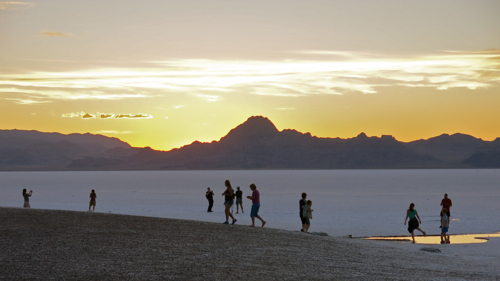
Kearney, Neb., is named after Fort Kearny, an army outpost established in 1848 to help protect the emigrants who were using the Oregon Trail in increasing numbers in the middle nineteenth century. As Interstate 80 heads west of Kearney, it roughly follows the old Oregon Trail along the Platte River, crossing and recrossing the Platte on anonymous bridges that you wouldn’t notice except for small signs identifying which channel or branch of the Platte you are driving over at 75 miles per hour. But in his 1847 book The Oregon Trail: Sketches of Prairie and Rocky-Mountain Life, Francis Parkman tells of a very different experience crossing the Platte River:
“The emigrants re-crossed the river, and we prepared to follow. First the heavy ox-wagons plunged down the bank, and dragged slowly over the sand-beds; sometimes the hoofs of the oxen were scarcely wetted by the thin sheet of water; and the next moment the river would be boiling against their sides, and eddying fiercely around the wheels. Inch by inch they receded from the shore, dwindling every moment, until at length they seemed to be floating far in the very middle of the river. A more critical experiment awaited us; for our little mule-cart was but ill-fitted for the passage of so swift a stream. We watched it with anxiety till it seemed to be a little motionless white speck in the midst of the waters; and it WAS motionless, for it had stuck fast in a quicksand. The little mules were losing their footing, the wheels were sinking deeper and deeper, and the water began to rise through the bottom and drench the goods within. All of us who had remained on the hither bank galloped to the rescue; the men jumped into the water, adding their strength to that of the mules, until by much effort the cart was extricated, and conveyed in safety across.”
We stopped at Gothenberg, Neb., to see the Pony Express station. The pleasant woman sitting in the station told us it was relocated from a ranch about thirty miles away, reassembled in the town park, a new roof put on, a brick floor put down, and concrete put between the logs to keep the weather out.
On the way out of town, we stopped at Lisa’s Kitchen for an early lunch. Lisa was outside watering the flowers in front of the restaurant, and she came in to take our order. While she cooked my hamburger, she and I got to talking. I admired the photographs of her grandchildren. There was also a framed photograph of her daughter hanging on one wall, and on the opposite wall a large framed photograph of Lisa, looking quite glamorous and scholarly, from when she lived in Hong Kong. When she heard that Carol and I live in the Bay Area, she said that her daughter lives in the Mission District in San Francisco. She and I agreed that the price of housing in the Bay Area is ridiculously high.
As we were getting in to the car, she waved at us, picked a lily, and came over and gave it to us. The blossom stayed in a large paper cup in the center console of the car for the rest of the day.
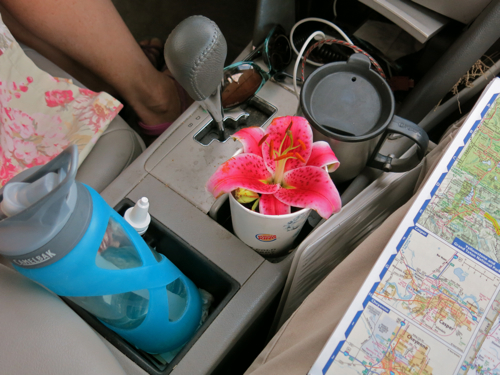
We stopped to have lunch at a rest area in Nebraska. We got out of the car, and it seemed warm and windy, but not oppressively hot — just comfortably warm. When I checked the thermometer, however, it read 99 degrees! We were back in the West, where the dry heat isn’t uncomfortable, it just sucks all the moisture out of your body until you feel faint. Carol had washed a pair of pajamas and we hung them out to dry while we were eating lunch, but they were probably dry before we had even opened the jam jar to make our sandwiches.
Before long, trees started to disappear from the landscape, and we began to see sagebrush growing alongside the highway. This was another sign that we were entering the West. The interstate climbed up the western end of Nebraska, we topped one rise and there, off in the blue distance, were the sharp peaks of the distant mountains. We crossed over the border into Wyoming, and soon saw snow-covered peaks. Mark Twain, in Roughing It, described his delight the first time he saw snow-covered peaks in the West:
“Two miles beyond South Pass City we saw for the first time that mysterious marvel which all Western untraveled boys have heard of and fully believe in, but are sure to be astounded at when they see it with their own eyes, nevertheless–banks of snow in dead summer time. We were now far up toward the sky, and knew all the time that we must presently encounter lofty summits clad in the ‘eternal snow’ which was so common place a matter of mention in books, and yet when I did see it glittering in the sun on stately domes in the distance and knew the month was August and that my coat was hanging up because it was too warm to wear it, I was full as much amazed as if I never had heard of snow in August before.”
He had spent several weary weeks in an overland stage before he saw that delightful sight; we had driven just a few days.
We stopped for dinner at a rest area in the Wagonhound region of Wyoming. A sign proclaimed that Indians had used the same spot for a rest area:
“The stone circles or ‘TIPI RINGS’ at this site mark the location of a prehistoric Native American campsite. The stones were probably used to anchor the skins of conical tents, known by the Sioux word ‘TIPI’…. It has been estimated that there are over 1 million tipi rings in the western United States. As such, they are one of the most common archaeological features to be found in this part of the country.”
Certainly, those prehistoric Native people picked a beautiful spot to set up their tipi.
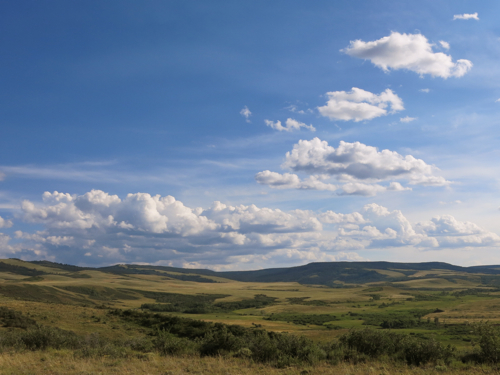
Above: The Wagonhound region of Wyoming
Sagebrush, snow-covered mountains, Indians — one more thing was needed for us to know that we were truly in the West: evidence of major resource extraction. But soon we saw a huge refinery alongside the interstate, out in the middle of nowhere:
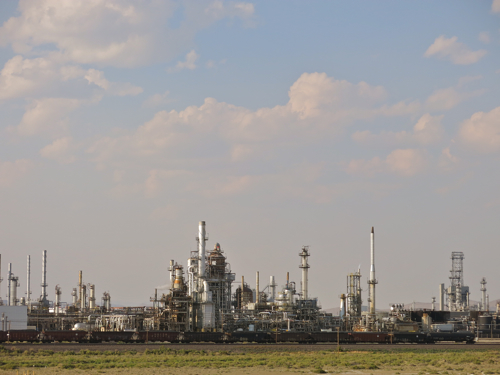
Above: Refinery near Sinclair, Wyo.
Then we passed an open pit mine that stretched for over two miles: huge piles of dirt with huge earthmoving equipment crawling over them; the top of a crane emerging from a some deep hole not far from the highway. Now we were truly in the West.
We started driving at nine in the morning, quickly leaving behind the crowded roads of Chicagoland.
Water towers are prominent features of the midwestern landscape, and traditionally the municipality that owns the water tower will paint its name on the side. Stuart, Iowa, has updated this tradition: a large white wind turbine had “STUART” painted in large letters down the tall tower.
We stopped at a rest area west of Des Moines, and as I looked out at a large field of corn I couldn’t help comparing the ecological characteristics of corn fields with lawns. Both crops cover large areas of North America (one source says that lawns cover more land area than any other single crop). Both crops are raised as monocultures that require huge amounts of chemical fertilizer and chemical controls for weeds and pests. Considered from the point of view of ecological science, both lawns and corn fields support a low density of species; and the “insurance hypothesis” predicts that lawns and corn fields will be relatively vulnerable to changes such as drought, invasive species, pest infestations, etc.
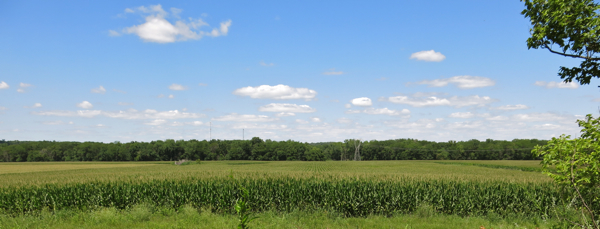
Above: Corn field near a rest stop west of Des Moines
As we drove by the Adair wind farm on Interstate 80, we could see a highway rest area with a tall white monument in front of it. As we passed it, we realized it wasn’t a monument at all: it was a wind turbine blade standing upright.
We decided to stop in Omaha for dinner. Carol found what sounded like a good restaurant, McFoster’s Natural Restaurant, using her smartphone. When we got there, we realized we had been at that restaurant some years earlier. At that time, the restroom walls had been covered with stickers, so Carol stuck one of her own stickers on the wall: a yellow spiral with the words “Urine Charge, Take Life Full Circle.” Alas, the restrooms had been renovated, and all the stickers were gone.
As we sat eating dinner, a couple in their early twenties walked in. The woman was saying to the man, “Yeah, I don’t know if you’ll like this place, but it’s my favorite restaurant. If you don’t like it, we can go somewhere else.” When they were out of earshot, Carol said aloud what I had been thinking: unless they were brother and sister, the man had better at least pretend that he liked that restaurant. As we were walking to our car, we saw them coming out of the restaurant; they both seemed to be in a good mood.
We had a long way to go, so we got in the car and kept driving west, into the setting sun….
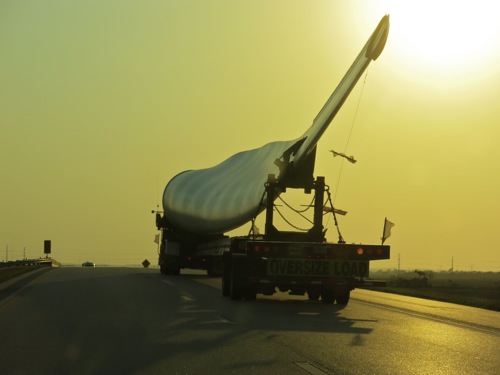
Above: Wind turbine on Interstate 80 in Nebraska
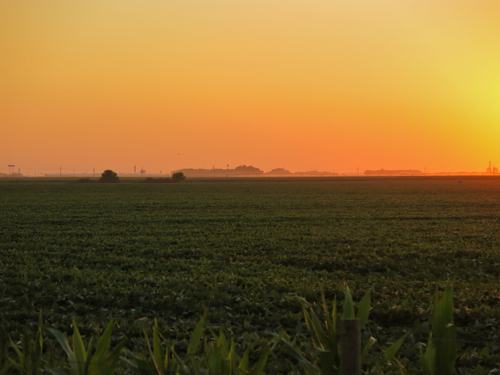
Above: Sun setting over a Nebraska soybean field
I got up at 6:30 and went to the gas station across the street from our motel to buy a newspaper. They stocked three, and I got a copy of each — the Akron Beacon Journal, the Cleveland Plain Dealer, and USA Today — and went to the Bob Evans restaurant to spend an hour eating breakfast and reading newspapers.
The lead paragraph of one of the front page articles in the Beacon Journal declared: “Amid sirens and cheers, the 77th Annual All-American Soap Box Derby kicked off its weeklong festivities with the opening ceremony Monday.” I remembered seeing a small black trailer hitched to a car in the parking lot outside our motel, with a sign that Kara’s something-or-other soapbox derby team. Sure enough, just as I was coming out from the restaurant, the car and trailer drove past me. Someone had taken white chalk and written on the side of the trailer: Honk for Luck!” I was walking so I couldn’t honk, but I silently wished Kara (whoever she may be) the best of luck in the world championships.
We left Macedonia and drove along Interstate 80 until we reached Illinois Route 53 — also known as Historic Route 66 — and headed south a dozen miles to the Midewin National Tallgrass Prairie. Midewin was established eighteen years ago on what used to be the old Joliet Arsenal. The prairie is still being restored by the National Forest Service, which maintains huge seed beds of native prairie plants, protected from deer by nine foot high fences. I stopped to look at a bed of Wild Bergamot (Monardo fistulosa) in full bloom.
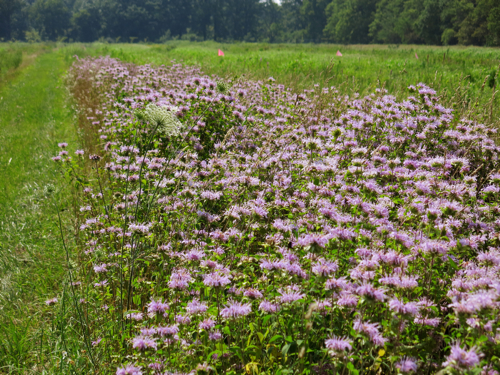
Above: Seed beds with Wild Bergamot (Beebalm) at Midewin National Tallgrass Prairie
We walked along an access road lined with trees to get to the trailhead; stopping to eat some perfectly ripe mulberries. It was hot and humid, too hot to walk in the sun. We headed down Prairie Creek Trail, one of the few shaded trails at Midewin. When we emerged from the woods an hour later, the sun was partly blocked by clouds, but it was still too hot. I walked slowly, paying attention to the birds — that was my excuse for walking slowly. Carol pointed to a Ring-necked Pheasant walking along the trail behind us. A Sedge Wren called from the top of a shrub. A bright blue Indigo Bunting landed on a fence, not fifty feet from me.
Carol walked faster than I. She disappeared out of sight into the shaded access road. I stopped and turned to look out over the prairie and the woodlands. Even though I could hear the constant rumble of trucks along nearby Interstate 55, I felt as though I were far from that world.
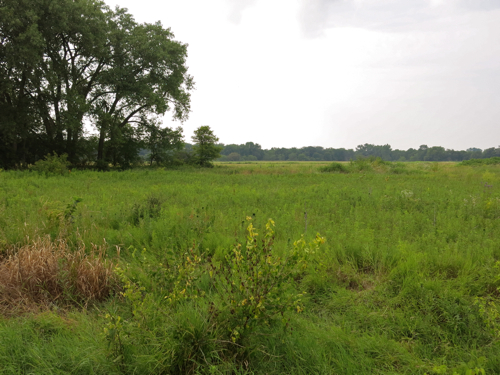
Above: Midewin National Tallgrass Prairie
After we checked in to our motel in Joliet, we went out to eat at a little Chinese restaurant in a half-abandoned mall. That big empty mall parking lot resembled the tallgrass prairie in an eerie, slightly sinister way — the way the Fetch of Irish folklore resembles a living human being.
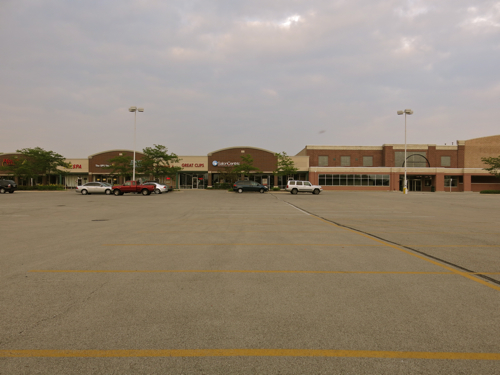
Above: Mall in Joliet, Ill.
We had a short drive today because we are visiting relatives this afternoon and evening. We got an early start, and as we were driving along we realized that it was a perfect beach day: hot, but not too hot, sunny, a light breeze. So we decided to go to the beach in western Pennsylvania.
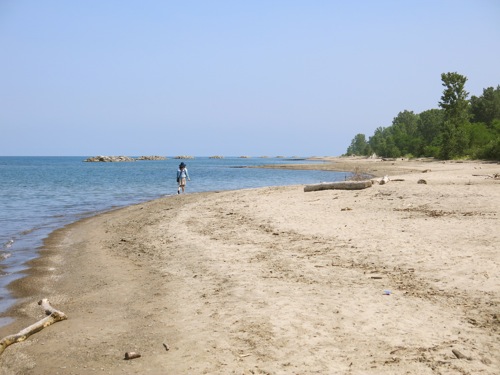
Above: Presque Isle, Penna.
There are miles of beaches on Presque Isle, just north of Erie, with sand, seagulls, the occasional seashell, and reasonably warm water. If you’re willing to walk five minutes, you can get away from the crowded swimming beaches and have long stretches of sand pretty much to yourself.
Carol stood at the end of a low concrete wall, presumably there to control erosion, and looked across Lake Erie. If you looked carefully, you could just see a few big buildings on the opposite shore shimmering through the humidity.
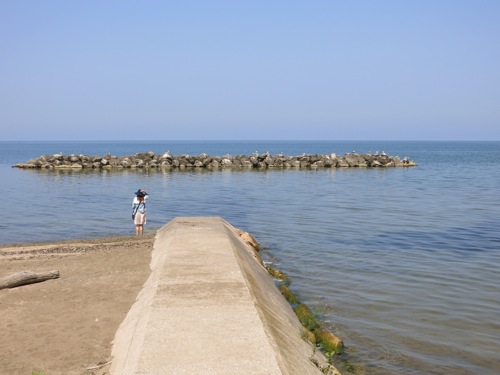
Above: Presque Isle, Penna.
We walked for over an hour on the beach. There were lots of small flat stones that were perfect for skipping, and I managed to skip one stone seven times before it sank into the water. We saw lots of interesting driftwood, too, and someone had built a couple of lean-to structures out of big pieces of driftwood, sort of like the forts kids build in the woods.
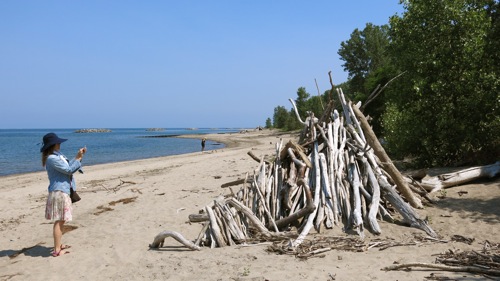
Above: Presque Isle, Penna.
It was pretty idyllic.
We left Stow, Massachusetts, at nine o’clock this morning. Stow lies on the edge of the coastal plain of southeastern New England, and we drove west through the hills of central New England, into the Berkshire Mountains, through the Taconic Mountains of New York, up the Mohawk River valley through the dramatic gap between the foothills of the Adirondack Mountains to the north and the Catskills to the south. I said goodbye to the last little foothills along the freeway.
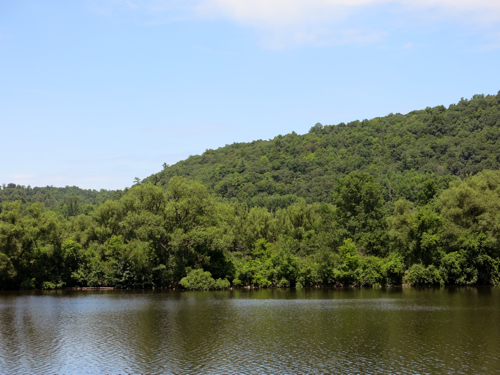
Above: The Mohawk River along Interstate 90, looking north towards the last of the Adirondack foothills.
We will see no more mountains — nothing but plains and rolling land — until we reach Wyoming, some 1,500 miles from here. We stopped at a rest area near Waterloo, New York, and already the landscape began to look like the Midwest or the Great Plains: a big field of legumes, a line of trees in the distance, some farm buildings, and a big outlet mall on the other side of the interstate.
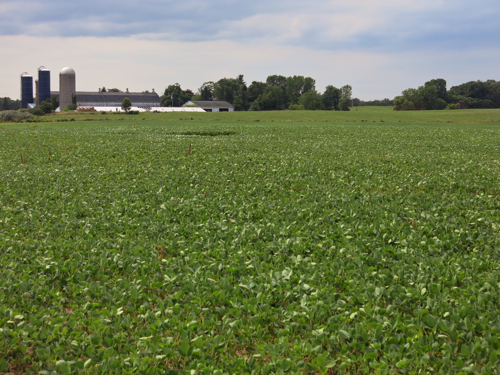
Above: Farm off Nine Foot Road, near Waterloo, N.Y.
When we got to Fredonia, N.Y., where we will spend the night, we took a long walk from our hotel to the campus of SUNY Fredonia. Although the university was founded in 1829, it obviously saw a big building boom beginning in the 1960s, when lots of big bland institutional brick buildings got built. I imagine it can look pretty bleak in the long gray winters, but everything was beautifully green today.
Fredonia obviously has a big student population. Lots of the attractive older houses in the center of town have been split up into student apartments, and we saw lots of evidence that this is a university town: a peace sign in a window, a poster proclaiming allegiance to Bob Marley, and a lovely garden with a handpainted sign that read “GROW FOOD NOT LAWNS.”
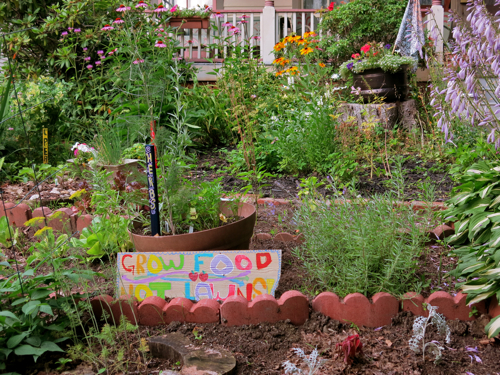
Above: Garden in Fredonia, N.Y.
Gosport Harbor is protected by several islands connected by breakwaters: Appledore Island to the north west, then Malaga Island, Smuttynose Island, Cedar Island, and Star Island. The boundary between Maine and New Hampshire goes through the harbor; Star Island is in New Hampshire, and the other islands are in Maine. Here are three photos of Gosport Harbor, taken from Star Island over the past week:
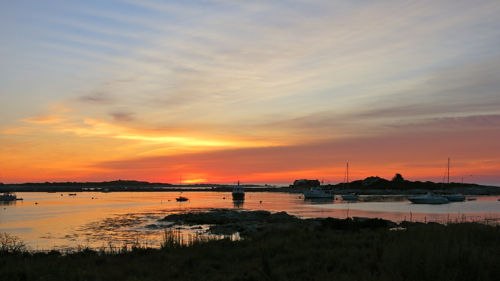
Above: Sunrise over Smuttynose Island (at left) and Cedar Island, Friday morning at about 5 a.m.
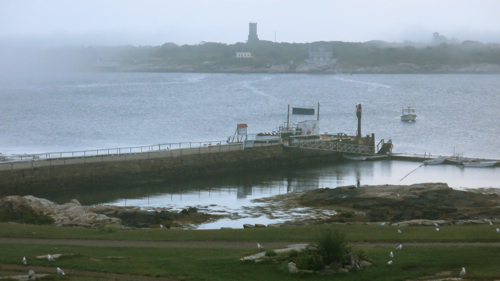
Above: Looking across the harbor towards Appledore Island, Thursday morning at about 5 a.m.
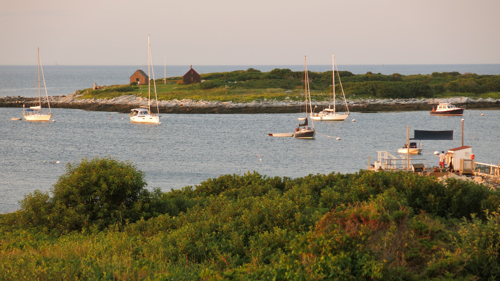
Above: West end of Smuttynose Island, late afternoon on Friday — the brown house (left of center, near the horizon line) is perhaps the oldest still-standing house in Maine.